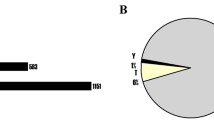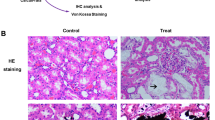Abstract
Nephrogenesis requires a fine balance of many factors that can be disturbed by intrauterine growth restriction (IUGR), leading to a low nephron endowment. The aim of this study was to test the hypothesis that IUGR affects expression of key proteins that regulate nephrogenesis, by a comparative proteomic approach. IUGR was induced in Sprague–Dawley (SD) rats by isocaloric protein restriction in pregnant dams. A series of methods, including two-dimensional gel electrophoresis (2-DE), silver staining, mass spectrometry and database searching was used. After silver staining, 2-DE image analysis detected an average 730 ± 58 spots in the IUGR group and 711 ± 73 spots in the control group. The average matched rate was 86% and 81%, respectively. The differential proteomic expression analysis found that 11 protein spots were expressed only in the IUGR group and one in the control group. Seven protein spots were up-regulated more than fivefold and two were down-regulated more than fivefold in the IUGR group compared with those in control group. These 21 protein spots were preliminarily identified and were structural molecules, including vimentin, perlecan, gamma-actin and cytokeratin 10, transcription regulators, transporter proteins, enzymes, and so on. These proteins were involved primarily in energy metabolism, oxidation and reduction, signal transduction, cell proliferation and apoptosis. Data from this study may provide, at least partly, evidence that abnormality of metabolism, imbalance of redox and apoptosis, and disorder of cellular signal and cell proliferation may be the major mechanisms responsible for abnormal nephrogenesis in IUGR.





Similar content being viewed by others
References
Barker DJ, Gluckman PD, Godfrey KM, Harding JE, Owens JA, Robinson JS (1993) Fetal nutrition and cardiovascular disease in adult life. Lancet 341:938–941
Armitage JA, Taylor PD, Poston L (2005) Experimental models of developmental programming: consequences of exposure to an energy rich diet during development. J Physiol 565:3–8
Silver LE, Decamps PJ, Korst LM, Platt LD, Castro LC (2003) Intrauterine growth restriction is accompanied by decreased renal volume in the human fetus. Am J Obstet Gynecol 188:1320–1325
Latini G, De Mitri B, Del Vecchio A, Chitano G, De Felice Z, Zetterström R (2004) Foetal growth of kidneys, liver and spleen in intrauterine growth restriction: “programming” causing “metabolic syndrome” in adult age. Acta Paediatr 93:1635–1639
Rodríguez-Soriano J, Aguirre M, Oliveros R, Vallo A (2005) Long-term renal follow-up of extremely low birth weight infants. Pediatr Nephrol 20:579–584
Hoy WE, Rees M, Kile E, Mathews JD, Wang Z (1999) A new dimension to the Barker hypothesis: low birthweight and susceptibility to renal disease. Kidney Int 56:1072–1077
Chen J, Xu H, Shen Q, Guo W, Sun L, Lin SY (2006) Influence of intrauterine growth retardation on blood pressure and renal function in rats. Zhanghua Shen Zang Bing Za Zhi 22:706–707
Godfrey KM, Barker DJ (2000) Fetal nutrition and adult disease. Am J Clin Nutr 71:1344S–1352S
Martins JP, Monteiro JC, Paixão AD (2003) Renal function in adult rats subjected to prenatal dexamethasone. Clin Exp Pharmacol Physiol 30:32–37
Mañalich R, Reyes L, Herrera M, Melendi C, Fundora I (2000) Relationship between weight at birth and the number and size of renal glomeruli in humans: a histomorphometric study. Kidney Int 58:770–773
Thame M, Osmond C, Wilks RJ, Bennett FI, McFarlane-Anderson N, Forrester TE (2000) Blood pressure is related to placental volume and birth weight. Hypertension 35:662–667
Wu G, Bazer FW, Cudd TA, Meininger CJ, Spencer TE (2004) Maternal nutrition and fetal development. J Nutr 134:2169–2172
Sahajpal V, Ashton N (2003) Renal function and angiotensin AT1 receptor expression in young rats following intrauterine exposure to a maternal low-protein diet. Clin Sci 104:607–614
do Carmo Pinho Franco M, Nigro D, Fortes ZB, Tostes RC, Carvalho MH, Lucas SR, Gomes GN, Coimbra TM, Gil FZ (2003) Intrauterine undernutrition—renal and vascular origin of hypertension. Cardiovasc Res 60:228–234
Alexander BT (2003) Intrauterine growth restriction and reduced glomerular number: role of apoptosis. Am J Physiol Regul Integr Comp Physiol 285:R933–R934
Pham TD, MacLennan NK, Chiu CT, Laksana GS, Hsu JL, Lane RH (2003) Uteroplacental insufficiency increases apoptosis and alters p53 gene methylation in the full-term IUGR rat kidney. Am J Physiol Regul Integr Comp Physiol 285:962–970
Arthur JM, Thongboonker V, Scherzer JA, Cai J, Pierce WM, Klein JB (2002) Differential expression of proteins in renal cortex and medulla: a proteomic approach. Kidney Int 62:1314–1321
Thongboonker V, Barati MT, McLeish KR, Benarafa C, Remold-O’Donnell E, Zheng S, Rovin BH, Pierce WM, Epstein PN, Klein JB (2004) Alterations in the renal elastin-elastase system in type 1 diabetic nephropathy identified by proteomic analysis. J Am Soc Nephrol 15:650–662
Thongboonker V (2004) Proteomics in nephrology: current status and future directions. Am J Nephrol 24:360–378
Schaub S, Rush D, Wilkins J, Gibson IW, Weiler T, Sangster K, Nicolle L, Karpinski M, Jeffery J, Nickerson P (2004) Proteomic-based detection of urine proteins associated with acute renal allograft rejection. J Am Soc Nephrol 15:219–227
Weinkauf M, Hiddemann W, Dreyling M (2006) Sample pooling in 2-D gel electrophoresis: a new approach to reduce nonspecific expression background. Electrophoresis 27:4555–4558
Karp NA, Lilley KS (2009) Investigating sample pooling strategies for DIGE experiments to address biological variability. Proteomics 9:388–397
Jia SQ, Niu ZJ, Zhang LH, Zhong XY, Shi T, Du H, Zhang GG, Hu Y, Su XL, Ji JF (2009) Identification of prognosis-related proteins in advanced gastric cancer by mass spectrometry-based comparative proteomics. J Cancer Res Clin Oncol 135:403–411
Ivaska J, Pallari HM, Nevo J, Eriksson JE (2007) Novel functions of vimentin in cell adhesion, migration, and signaling. Exp Cell Res 313:2050–2062
Murer L, Benetti E, Centi S, Della Vella M, Artifoni L, Capizzi A, Zucchetta P, Del Prete D, Carasi C, Montini G, Rigamonti W, Zaccello G (2006) Clinical and molecular markers of chronic interstitial nephropathy in congenital unilateral ureteropelvic junction obstruction. J Urol 176:2668–2673
Sanai T, Sobka T, Johnson T, el-Essawy M, Muchaneta-Kubara EC, Ben Gharbia O, el Oldroyd S, Nahas AM (2000) Expression of cytoskeletal proteins during the course of experimental diabetic nephropathy. Diabetologia 43:91–100
Bob FR, Gluhovschi G, Herman D, Potencz E, Gluhovschi C, Trandafirescu V, Schiller A, Petrica L, Velciov S, Bozdog G, Vernic C (2008) Histological, immunohistochemical and biological data in assessing interstitial fibrosis in patients with chronic glomerulonephritis. Acta Histochem 110:196–203
Kim YH, Goyal M, Kurnit D, Wharram B, Wiggins J, Holzman L, Kershaw D, Wiggins R (2001) Podocyte depletion and glomerulosclerosis have a direct relationship in the PAN-treated rat. Kidney Int 60:957–968
Zou J, Yaoita E, Watanabe Y, Yoshida Y, Nameta M, Li H, Qu Z, Yamamoto T (2006) Upregulation of nestin, vimentin, and desmin in rat podocytes in response to injury. Virchows Arch 448:485–492
Lucas SR, Miraglia SM, Zaladek Gil F, Machado Coimbra T (2001) Intrauterine food restriction as a determinant of nephrosclerosis. Am J Kidney Dis 37:467–476
Knox SM, Whitelock JM (2006) Perlecan: how does one molecule do so many things? Cell Mol Life Sci 63:2435–2445
Whitelock JM, Melrose J, Iozzo RV (2008) Diverse cell signaling events modulated by perlecan. Biochemistry 47:11174–11183
Björnson Granqvist A, Ebefors K, Saleem MA, Mathieson PW, Haraldsson B, Nyström JS (2006) Podocyte proteoglycan synthesis is involved in the development of nephrotic syndrome. Am J Physiol Renal Physiol 291:F722–F730
Ha TS, Song CJ, Lee JH (2004) Effects of advanced glycosylation endproducts on perlecan core protein of glomerular epithelium. Pediatr Nephrol 19:1219–1224
Kanwar YS, Liu ZZ, Kumar A, Usman MI, Wada J, Wallner EI (1996) D-glucose-induced dysmorphogenesis of embryonic kidney. J Clin Invest 98:2478–2488
Alexander-Kaufman K, Harper C (2009) Transketolase: observations in alcohol-related brain damage research. Int J Biochem Cell Biol 41:717–720
Zhao J, Zhong CJ (2009) A review on research progress of transketolase. Neurosci Bull 25:94–99
Krishna SB, Alfonso LF, Thekkumkara TJ, Abbruscato TJ, Bhat GJ (2007) Angiotensin II induces phosphorylation of glucose-regulated protein-75 in WB rat liver cells. Arch Biochem Biophys 457:16–28
Hanniman EA, Lambert G, Inoue Y, Gonzalez FJ, Sinal CJ (2006) Apolipoprotein A-IV is regulated by nutritional and metabolic stress: involvement of glucocorticoids, HNF-4 alpha, and PGC-1 alpha. J Lipid Res 47:2503–2514
Kedishvili NY, Goodwin GW, Popov KM, Harris RA (2000) Mammalian methylmalonate-semialdehyde dehydrogenase. Methods Enzymol 324:207–218
Wong PT, Leong SF (1985) Delta-1-pyrroline-5-carboxylate dehydrogenase, a possible regulatory enzyme in transmitter glutamic acid metabolism—a preliminary report. Ann Acad Med Singapore 14:143–146
Gagnon I, Duester G, Bhat PV (2003) Enzymatic characterization of recombinant mouse retinal dehydrogenase type 1. Biochem Pharmacol 65:1685–1690
Wei CC, Zhang SL, Chen YW, Guo DF, Ingelfinger JR, Bomsztyk K, Chan JS (2006) Heterogeneous nuclear ribonucleoprotein K modulates angiotensinogen gene expression in kidney cells. J Biol Chem 281:25344–25355
Zhang B, Zhang Y, Dagher MC, Shacter E (2005) Rho GDP dissociation inhibitor protects cancer cells against drug-induced apoptosis. Cancer Res 65:6054–6062
Wei L, Imanaka-Yoshida K, Wang L, Zhan S, Schneider MD, DeMayo FJ, Schwartz RJ (2002) Inhibition of Rho family GTPases by Rho GDP dissociation inhibitor disrupts cardiac morphogenesis and inhibits cardiomyocyte proliferation. Development 129:1705–1714
Wang J, Chen L, Li D, Yin Y, Wang X, Li P, Dangott LJ, Hu W, Wu G (2008) Intrauterine growth restriction affects the proteomes of the small intestine, liver, and skeletal muscle in newborn pigs. J Nutr 138:60–66
Acknowledgements
This research was funded by the National Natural Science Foundation of China (NSFC, 30672242). We are grateful to Xiu-Rong Zhang and Zhong-Hua Zhao for their technical assistance.
Author information
Authors and Affiliations
Corresponding author
Rights and permissions
About this article
Cite this article
Shen, Q., Xu, H., Wei, LM. et al. A comparative proteomic study of nephrogenesis in intrauterine growth restriction. Pediatr Nephrol 25, 1063–1072 (2010). https://doi.org/10.1007/s00467-009-1437-x
Received:
Revised:
Accepted:
Published:
Issue Date:
DOI: https://doi.org/10.1007/s00467-009-1437-x




